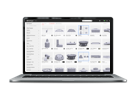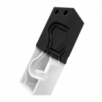
Additive manufacturing with composite materials in aerospace and defense
An Air Force engineer's insights into additive manufacturing applications in the Department of Defense and the growing impact of 3D printing in industry
Jordan Weininger is an Advanced Composites Engineer in the United States Air Force. He works in the Advanced Composites Office at Hill Air Force Base. The opinions expressed here by Jordan Weininger are based on his own experience and do not reflect the views of the U.S. Air Force.
The manufacturing technologies of the future are already here, but the challenge is bringing these technologies to the industries where they can make a difference. It's not just about developing the technology, but also ensuring you have repeatable processes and allowable B-base values—the minimum allowable mechanical properties required to design a part from a given material—to implement these new technologies in the real world.
Through my current work in composites engineering in the Advanced Composites Group at Hill Air Force Base, I have been fortunate to gain insight into the applications of advanced additive manufacturing technology in the aerospace and defense industries and to learn about the larger impact of industrial 3D printing outside of the Department of Defense.
Composite materials technology in the US Air Force

F-16 Fighting Falcon leaves Hill Air Force Base
Composites engineering is a field that is gaining application in more and more industries every year. The desire to work in this field led me to the Air Force and specifically to the Advanced Composites Office. This is an Air Force office, but we support all DoD organizations. In addition to addressing problems in composites design, analysis, engineering, and repair, we also offer one-week courses for DoD organizations and their personnel. These courses include an introduction to composites engineering and an advanced technician course. In these courses, students from across the Department of Defense can gain hands-on experience in composites design and repair.
Industrial expansion of 3D printing
In my work across various industries, I've heard countless stories of additively solving prototyping problems for businesses, especially small businesses. In the small business production cycle, the ability to prototype functional components before going through the steps necessary to ramp up mass production is critical to success.
With the diverse printable materials available today—from metals to composites to thermoplastics beyond PLA—3D printing enables fit and function testing for engineers and provides the necessary digitization medium to build a business case in the early stages of product development. It's not necessarily the additive part that completely solves a problem, but rather 3D printing in general. 3D printing technology enriches so many critical steps in the design process that production problems can be more easily solved.
I think additive manufacturing will grow in the tooling space: brackets and hinges, fasteners, and manufacturing aids. In the near future, we'll see 3D printing enter the realm of functional end-use parts. It started with PLA, which anyone could print in their garage. Now that companies like Markforged are able to print composites and metals, these stronger and more useful materials open a whole new door for additive manufacturing.
The quality and strength of the materials available for 3D printing are transforming the economic and technological possibilities for all types of businesses. For low-volume parts, 3D printing is now cheaper than creating a mold or CNC machining parts from a block. This opens the door to a number of new industries adopting 3D printing.
Why the Air Force is switching to additive processes

Maintenance work on a C-130 at Hill Air Force Base
Direct applications for 3D printing in the Air Force and military are also increasing. There are two key areas that directly relate to the military's use of additive manufacturing.
1. Small series production: For the aircraft we work on, we don't produce hundreds of thousands of parts, as we would with a production part. Aerospace and military applications are typically small batches, and sometimes these parts can be manufactured on-site, depending on the available additive manufacturing technology.
2. Distributed manufacturing: The strength of additive manufacturing also lies in its distributed nature. If 3D printers can be set up cost-effectively at different locations, you don't have to ship a new part from across the world if something breaks. With additive manufacturing, you're not dependent on a single production source. Multiple printers at different locations can produce parts.
Because of these factors, I see additive manufacturing playing a much larger role in the military and aerospace industries.
Additive tooling for the repair of older aircraft – MRO

An aerial view of decommissioned military aircraft in storage
The Advanced Composite Materials Office is tasked with finding solutions for the development, analysis, design, and repair of composite materials, particularly through the Life Cycle Management Center, which focuses on the repair of older aircraft. Often, the original tooling for aircraft has been destroyed or misplaced, and we can use additive manufacturing to create new tooling for these aircraft so they can continue to fly.
One of my main goals is to develop additive tools that will allow us to produce composite materials for these aircraft. When we're manufacturing parts for an older aircraft for which we no longer have tooling or CAD data, we sometimes create a 3D scan of an existing part and then work from there to create a model that we can then 3D print and use as a tool for that part.
Additive manufacturing for composite tools

Collin Fisher, 533rd Commodities Maintenance Squadron, works with an aircraft part of the F-16 wing assembly
At the Advanced Composites Office, we are interested in 3D printing from a composites perspective and how it can support the manufacturing process. Currently, many companies use large-scale 3D-printed fused deposition modeling (FDM) parts for tooling, but they require post-printing and post-processing of the parts before preparing them for a composites lab.
This means that an accurate CAD drawing or model must be printed, which is then machined on a CNC machine and then prepared for the composite buildup with a mixture of sealants to make it vacuum-tight and mold release agents. We would like to eliminate this step—the mounting on the CNC machine—because it negates many of the advantages of additive manufacturing of tools.
In my opinion, the main advantages of additive manufacturing for tools are the ability to quickly and easily obtain a part that exactly matches the CAD design. If you need to post-process the mold before using it to manufacture a composite part, you could also use a type of tool plate, which is much cheaper and just as easy to machine. However, if we can eliminate the post-processing step, we can save a lot of time and energy.
If we can produce a 3D-printed part with a vacuum-tight surface, without any post-processing, manual grinding, or anything that might compromise the accuracy of the geometry, I can envision a world where additive manufacturing is widely used for the production of composite tooling. This is a really important area that's just beginning to emerge for 3D printing.










Leave A Comment